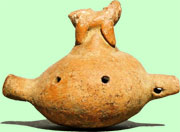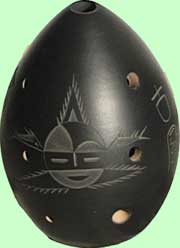 |
: The ocarina |
||||||||
| Although not falling directly within the framework of this site, it is interesting here to give some information on the other globular ceramics flutes.
Ocarinas |
 Donati making ocarinas |
||||||||
| This flute performes like a globular whistle. The airflow is guided towards the edge of a hole made directly in the globular cavity. It creates the vibration of the air contained in the cavity. The basic sound of the ocarina thus depends only on the volume of this cavity. The variation of the sound is carried out thanks to finger holes opened in the globular body. Although the height of the sound doesn't depend on the position of the finger holes but of the total opened surface, the position of the ocarinas finger holes is fixed mainly for technical considerations. So a system of playing close to the one of the tubular flute makes possible to play a diatonic or chromatic range exploiting associations of the open finger holes. In order to increase the range of the instrument, several sizes of ocarinas are made. The history of this instrument is largely detailed on many Web sites among which one can quote: http://www.ocarina.it/history.htm , an Italian site of a manufacter from Budrio, the ocarina inventor's birthplace. The traditional shaped ocarina is still manufactured everywhere in the world. Its use in a Japanese cartoon even conferred it an unequalled celebrity. Today, many ceramists manufacture globular flutes of varied shapes which they generally name ocarinas so that this term passed in the common vocabulary to indicate by extension all the globular flutes. |
|||||||||
| Pre-Colombian globular flutes . Are the thousands of artefacts of pre-Colombian musical ceramics whistles or globular flutes? These items existed in all the former American civilizations.
In some places, they represent more than a third of the ceramics figurines discovered. The number of finger holes is extremely varied like the shapes or the types of the mouth piece. |
 Globular flute 4 finger holes Private Col. |
||||||||
 Modern Chinese Xun |
The Chinese Xuns. The Chinese Xun are globular flutes known since the Neolithic in China and still used today in Asia for Confucian rituals. The ideogram for the 'xun' represents 'the feeling full with the sadness of the separation when a good-bye should be said'
The recent discovery of a small simple globular flute in the Neolithic site of Tieshan close to the town of Lushun was interpreted like the one of the ancestor of Xun. According to the periods, the xun finger hole number changed but the shape overall stayed unchanged. The xun has an ovoid shape with a flattened base and a mouth piece located at the apex. The Xun can be conected with the Korean Hun and the Huan in Vietnam. The Japanese Tsuchibue appeared towards 250 BC. It has six finger holes (four and two) but as a difference of the xun, the mouth piece is opened in the largest end of the instrument. |
||||||||